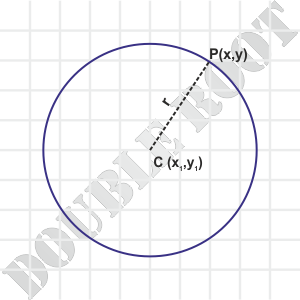In this lesson, we’ll talk about various forms of equations to a circle on the Cartesian plane. Let’s begin!
Equation of a Circle with Centre (x1, y1) and Radius r
To find the equation, we’ll pick any point on the circle and establish some relation between it’s coordinates that is always true. This relation will be the required equation.
Let C(x1, y1) be the center of the circle. Then, for any point P(x, y) on the circle, we have:
CP = r
Why? Because any point on the circumference is always at a fixed distance from the center of the circle. And this fixed distance is the radius.

Since we’re looking for a relation between the coordinates, we’ll bring in some coordinate geometry formulas. Using the distance formula, we can rewrite the above relation as:
\( \sqrt{(x-x_1)^2+(y-y_1)^2}=r\)
Finally, to make it look nicer, we’ll square both sides to get:
(x – x1)2 + (y – y1)2 = r2
Since the above relation is true for any point on the circle, it is the required equation of the circle.
General Equation of a Circle
Now, we’ve found the standard equation as well as the one above. But what kind of equation in general would represent a circle?
For example, which of the following equations represent a circle?
x2 + y – 2x – 4 = 0
x + y2 + 6x – 2y + 5 = 0
3x + 4y = 12
x2 + y2 – 2x + 4y + 1 = 0
The third equation represents a line, something that we learnt in a previous lesson. What about the other ones?
To answer that, we need to get a hang of the equation of any circle. Just like we did in this lesson, for a line.
So, let’s pick any circle, i.e. a circle with the center as (x1, y1) and radius as r, where x1, y1, and r (> 0) can have any value. Now, we’ll find it’s equation and look closely at the kind of terms we get.
From the previous section, the equation of this circle will be:
(x – x1)2 + (y – y1)2 = r2
If we expand the terms on the LHS, we’ll get something like this:
x2 + y2 – 2x1x – 2y1y + x12 + y12 – r2 = 0
The equation has the following types of terms.
Two terms of second degree: x2 and y2
Two terms of first degree: –2x1x and –2y1y
One constant term: –r2
Also, the second degree terms have the same coefficient (1 in this case).
Now consider this equation:
x2 + y2 + 2gx + 2fy + c = 0
This somewhat looks like the previous one (i.e. with respect to the number and types of terms).
Does this represent a circle, because it looks like the equation of a circle?
Turns out it does. We just have to make it look exactly like the one in the previous section. Let’s do that!
x2 + y2 + 2gx + 2fy + c = 0
⇒ (x2 + 2gx) + (y2 + 2fy) + c = 0 (rearranging the terms)
⇒ (x2 + 2gx + g2) + (y2 + 2fy + f2) + c = 0 + g2 + f2 (adding g2 and f2 on both sides)
⇒ (x2 + 2gx + g2) + (y2 + 2fy + f2) = g2 + f2 – c (subtracting c from both sides)
The equation can now be written as:
(x + g)2 + (y + f)2 = (\(\sqrt{g^2+f^2-c}\))2
This looks exactly like:
(x – x1)2 + (y – y1)2 = r2,
where g = –x1, f = –y1 and \(\sqrt{g^2+f^2-c}\) = r
Now,
(x – x1)2 + (y – y1)2 = r2 represents a circle whose center is (x1, y1) and radius is r.
Therefore,
x2 + y2 + 2gx + 2fy + c = 0 also represents a circle whose center is (–g, –f) and radius is \(\sqrt{g^2+f^2-c}\)
We’ll that’s it! We just learnt about the general equation of circle.
The only thing we need to ensure that g2 + f2 – c must be positive for the radius to be defined. If g2 + f2 – c is zero, the radius of the circle also becomes zero. In this case, the circle is called a point circle (something which you needn’t be worried about right now).
Lesson Summary
- The equation of the circle whose center is (x1, y1) and radius is r is given by (x – x1)2 + (y – y1)2 = r2.
- The general equation of a circle is x2 + y2 + 2gx + 2fy + c = 0, where the center is (–g, –f) and radius is \(\sqrt{g^2+f^2-c}\).
The next lesson will cover a few examples related to equations of the circle.